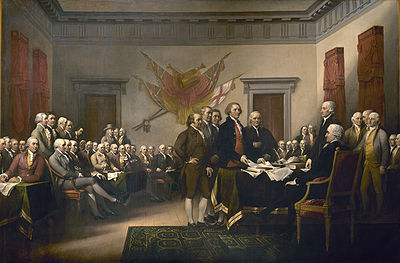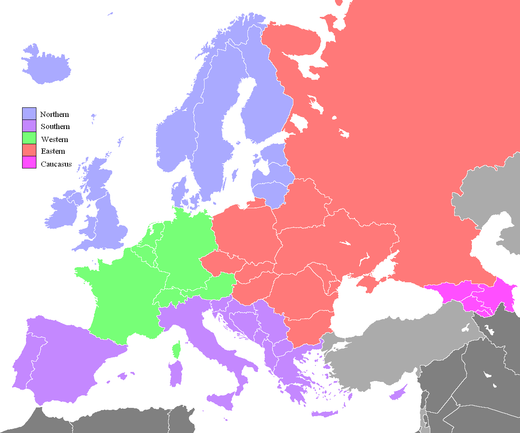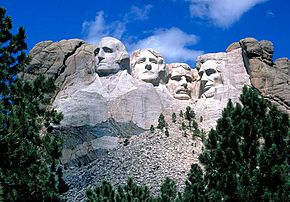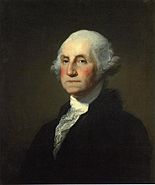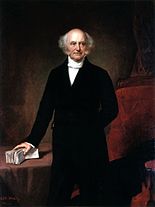- European American
-
This article is about the U.S. population of Americans of European ancestry. For the European diaspora throughout the world, see Emigration from Europe.
European American 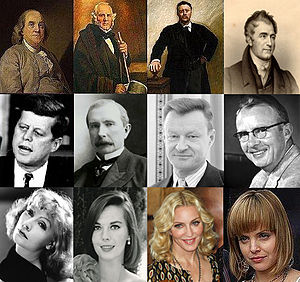
Benjamin Franklin - (English)[1] • Sam Houston - (Scotch-Irish)[2] • Theodore Roosevelt - (Dutch)[3] • Eleuthère Irénée du Pont - (French)[4] • John F. Kennedy - (Irish)[5] • John D. Rockefeller - (German)[6] • Zbigniew Brzezinski - (Polish)[7] • Luis Alvarez - (Spanish)[8] • Greta Garbo - (Swedish)[9] • Natalie Wood - (Russian)[10] • Madonna - (Italian/French)[11] • Mena Suvari - (Greek/Estonian)[12] Total population
223,553,265 (2010 Census)Regions with significant populations All areas of the United States Languages Predominantly English • Spanish • German • French • Italian • Dutch • Swedish • Polish • others
Religion Predominately Christian
Jewish • Muslim • Buddhist and others.Related ethnic groups A European American (also known as a Euro-American) is a citizen or resident of the United States who has origins in any of the original peoples of Europe. This includes people via African, North American, Caribbean, Central American or South American and Oceanian nations which have a large European diaspora.[13]
The Spanish were the first Europeans to establish a continuous presence in what is now the United States.[14] Martín de Argüelles born 1566, San Agustín, La Florida, was the first known person of European descent born in what is now the United States.[15] Twenty-one years later, Virginia Dare, born in 1587 on Roanoke Island in present-day North Carolina, was the first child born in the Thirteen Colonies to English parents.
In 2009, German Americans (16.5%), Irish Americans (11.9%), English Americans (9.0%) and Italian Americans (6.4%) were the four largest self-reported ancestry groups in the United States forming 43.8% of the total population.[16] British Americans (English, Scottish and Welsh) are estimated to be up to (20%) or (60,000,000) of the United States population.[17]
Overall, as the largest group, European Americans have the lowest poverty rate[18] and the second highest educational attainment levels, median household income,[19] and median personal income[20] of any racial demographic in the nation.
Contents
Terminology
Use
In 1995, as part of a review of the Office of Management and Budget's Statistical Policy Directive No. 15 (Race and Ethnic Standards for Federal Statistics and Administrative Reporting), a survey was conducted of census recipients to determine their preferred terminology for the racial/ethnic groups defined in the Directive. For the 'white' group, 'European American' came third, preferred by 2.35% of panel interviewees.[21] The term "European American" is not in popular use in the U.S. among the general public or in the mass media, and the terms "white" or "white American" are commonly used instead.
The term "European American" is more narrow than "White American" in terms of their official usage. The term is different from "Caucasian American", "White American", and "Anglo American",[22] though "European American" is sometimes used as a synonym for "White American". According to the Texas Association of Museums, "European American", "White American", and "Caucasian American" are terms that vary in their preference depending on the individual and their descent.[23]
"Anglo American" is a term commonly used in the southwestern United States in place of "white" or "European American". The term arrived to the United States via Britain, but is based on the Angles tribe. The term also has a more specific reference than either "White American" or "Caucasian American" since both of these terms include a larger group of people than what is acknowledged in Europe. Also, whereas the terms "White American" and "Caucasian American" carry somewhat ambiguous definitions, depending on the speaker, European American has a more specific definition and scope. According to sociologist Rosanne Skirble, the term "European American" has increased a little in use, especially among scholars, but "White American" and "Caucasian American" continue to be generally preferred, depending on the descent of the given individual(s) or group to which the term refers.[24]
Origin
The term was coined by some to emphasize the European cultural and geographical ancestral origins of Americans in the same way that is done for African Americans and Asian Americans. A European American awareness is still notable because 90% of the respondents classified as white on the U.S. Census knew their European ancestry.[25] Historically, the concept of an American was conceived in the U.S. as a person of European ancestry to the exclusion of African Americans and Native Americans.[26]
As a linguistic concern, the term is often meant to discourage a dichotomous view of the racial landscape between the normative white category and everyone else.[27] Margo Adair suggests that the recognition of specific European American ancestries allows certain Americans to become aware that they come from a variety of different cultures.[28]
Origins
European Emigration 1820-1978[29][30] Country Total Germany 6,978,000 Italy 5,294,000 Great Britain 4,898,000 Ireland 4,723,000 Austria-Hungary 4,315,000 Russia 3,374,000 Sweden 1,272,000 Norway 856,000 France 751,000 Greece 655,000 Portugal 446,000 Denmark 364,000 Netherlands 359,000 Finland 33,000 Total 34,318,000 Note: Many returned back to their country of origin U.S. Historical Populations [31] Country Immigrants
Before 1790Population
(1790 est.)[32]England* 230,000 1,900,000 Ulster Scot-Irish* 135,000 320,000 Germany[33] 103,000 280,000 Scotland* 48,500 160,000 Ireland* 8,000 200,000 Netherlands 6,000 100,000 Wales* 4,000 120,000 France 3,000 80,000 Jews[34] 2,000 -- Sweden and Other[35] 500 20,000 *British total 425,500 2,500,000+ Total[36] 950,000 3,929,214 African[37] immigrants before 1790:360,000, total ancestry in 1790:757,208. Since 1607, some 57 million immigrants have come to the United States from other lands. Approximately 10 million passed through on their way to some other place or returned to their original homelands, leaving a net gain of some 47 million people. Prior to 1960, the overwhelming majority came from Europe or European descent from Canada. In 1960 for example, 75.0% of foreign-born population in the U.S came from the region of Europe.[38]
Before 1881, the vast majority of immigrants, almost 86% of the total, arrived from northwest Europe, principally Great Britain, Ireland, Germany, and Scandinavia. The years between 1881 and 1893 the pattern shifted, in the sources of U.S. “New immigration”. Between 1894 and 1914, immigrants from southern, central, and eastern Europe accounted for 69% of the total.[39][40][41]
European Americans are largely descended from colonial American stock supplemented by two sizable waves of immigration from Europe. Approximately 53 percent of European Americans today are of colonial ancestry, and 47 percent are descended from European, Canadian, or Mexican (or any Latin American) immigrants who have come to the U.S. since 1790 (and post-independence Mexico supplied Mexican-American immigration since 1890). Today, each of the three different branches of immigrants are most common in different parts of the country.
Colonial
Founding Fathers, the Committee of Five were Franklin, Adams, Jefferson, Sherman and Livingston of primarily English, Scottish, Welsh descent.Colonial stock, which mostly consists of people of English, Irish, Welsh, or Scottish descent, may be found throughout the country but is especially dominant in the South. Some people of colonial stock, especially in the Mid-Atlantic states, are also descendants of German and Dutch immigrants. The vast majority of these are Protestants. The Pennsylvania Dutch (German American) population gave the state of Pennsylvania a high German cultural character. French descent, which can also be found throughout the country, is most concentrated in Louisiana, while Spanish descent is dominant in the Southwest and Florida. These are primarily Roman Catholic and were assimilated with the Louisiana Purchase and the aftermath of the Mexican-American War and Adams–Onís Treaty, respectively. The first large wave of European migration after the Revolutionary War came from Northern and Western Europe between about 1820 and 1890. Most of these immigrants were from Ireland, Germany, Sweden, Denmark and Britain, and with large numbers of Irish and German Catholics immigrating, Roman Catholicism became an important minority religion. Their descendants are dominant in the Midwest and West, although German descent is extremely common in Pennsylvania, and Irish descent is also common in urban centers in the Northeast. The Irish community and to some extent, Germans held onto their ethnic identity throughout the 19th and early half of the 20th centuries, as well of other European ethnic groups. (See also White ethnic).
Second wave
The second wave of European Americans arrived from the mid-1890s to the 1920s, mainly from Southern and Eastern Europe.[25] This wave included Italians, Greeks, Hungarians, Portuguese, Ukrainians, Russians, Poles and other Slavs. With large numbers of immigrants from Spain, Mexico, Spanish Caribbean, and South and Central America, White Hispanics have increased to 8% of the US population, and Texas, California, New York and Florida are important centers for them. California and the Northeast US has large numbers of Armenians as well. Armenia became independent after the fall of the USSR (1991).
Ancestry mapBulgarianEstonianScots-IrishSicilianMacedonianBasqueArmenianGeorgianCanadians including those of French Canadian backgrounds immigrated to the USA in fairly large numbers in the 19th and 20th centuries, with Quebec "Canado-Americain" communities known as Little Canadas formed in New England and the Midwestern United States in the early 20th century. Also to note the late 20th century snowbird winter residence phenomenon in warm weather climes of Florida, the Carolinas, southern Texas, Arizona, Southern California and Las Vegas, Nevada.
Australian immigrants first settled U.S. during California Gold Rush in 1850 and Australians continue to settle in California until 1890. Australians migrated again during World War II to the 1960s; with California, Hawaii, and New York are the concentration areas for them. New Zealand settlers accompanied Australians from 1971 to 1990. Since 1994, South African settlers of European background have permanently emigrated after the affirmative action policies of the ANC government. South African Americans had established themselves in Southern California, but there were Afrikaans refugees from the Boer War in the 1890s/early 1900s.
Culture
Mount Rushmore was sculpted by Danish American Gutzon Borglum. Sculptures of the heads of former United States presidents (from left to right) Washington, Jefferson, Roosevelt and Lincoln.[42] Walt Disney who created Mickey Mouse was of Irish, English, French and German descent.European American cultural lineage can be traced back to western Europe and is institutionalized in the form of its government, traditions, and civic education.[43] The Solutrean hypothesis suggested that Europeans may have been among the first in the Americas.[44][45][46] More recent research has argued this not to be the case and that the founding Native American population came from Siberia through Beringia. An article in the American Journal of Human Genetics states "Here we show, by using 86 complete mitochondrial genomes, that all Native American haplogroups, including haplogroup X, were part of a single founding population, thereby refuting multiple-migration models."[47]
Since most later European Americans have assimilated into American culture, most European Americans now generally express their individual ethnic ties sporadically and symbolically and do not consider their specific ethnic origins to be essential to their identity; however, European American ethnic expression has been revived since the 1960s.[25] Southern Europeans, specifically Italian and Greeks (see Greek American), have maintained high levels of ethnic identity. Same applied to Polish Americans and American Jews. In the 1960s, Mexican Americans and African Americans started exploring their cultural traditions as the ideal of cultural pluralism took hold.[25] European Americans followed suit by exploring their individual cultural origins and having less shame of expressing their unique cultural heritage.[25]
Four regions
In his 1989 book "Albion's Seed: Four British Folkways in America" (ISBN 0195069056), David Hackett Fischer explores the details of the folkways of four different groups of settlers from the British Isles that came to the American colonies during the 17th and 18th centuries from distinct regions of Britain and Ireland. His thesis is that the culture of each group persisted (albeit in modified form), providing the basis for the modern United States.
According to Fischer, the foundation of America's four regional cultures was formed from four mass migrations from four different regions of the British Isles by four distinct ethno-cultural groups. New England's formative period occurred between 1629 and 1640 when Puritans, mostly from East Anglia in England, settled there, thus forming the basis for the New England regional culture. The next mass migration was of southern English cavaliers and their Irish and Scottish servants to the Chesapeake Bay region between 1640 and 1675. This spawned the creation of the American Southern culture.
Then, between 1675 and 1725, thousands of Irish, English and German Quakers, led by William Penn, settled the Delaware Valley. This resulted in the formation of the General American culture, although, according to Fischer, this is really a "regional culture," even if it does today encompass most of the U.S. from the mid-Atlantic states to the Pacific Coast. Finally, a huge number of Irish, Scottish and English settlers from the borderlands of Britain and Ireland migrated to Appalachia between 1717 and 1775. This left a distinctive Celtic cultural imprint on this region, and resulted in the formation of the Upland South regional culture, which has since expanded to the west to West Texas and parts of the U.S. Southwest.
In his book, Fischer brings up several interesting points. He states that the U.S. is not a country with one "general" culture and several "regional" culture, as is commonly thought. Rather, there are only four regional cultures as described above, and understanding this helps one to more clearly understand American history as well as contemporary American life. Fischer also asserts that it is not only important to understand where different groups came from, but when. All population groups have, at different times, their own unique set of beliefs, fears, hopes and prejudices. When different groups came to America and brought certain beliefs and values with them, these ideas became, according to Fischer, more or less frozen in time, even if they eventually changed in their original place of origin.
Demographics
Main articles: United States Census and 2010 United States CensusAt the 2010 Census there were 223,553,265 "White Americans", which includes 26.7 million White Hispanic and Latino Americans. That is, there are 196.8 million "Non-Hispanic Whites" (63.7% of the total population) and 26,735,713 White Hispanic and Latino Americans (8.7% of the population). Non-Hispanic Whites together with White Hispanic and Latino Americans form the census category of "White Americans" - see Race and ethnicity.
The numbers below give numbers of European Americans as measured by the U.S. Census in 1980, 1990, and 2000. The numbers are measured according to declarations in census responses. This leads to uncertainty over the real meaning of the figures: For instance, as can be seen, according to these figures, the European American population dropped 40 million in ten years, but in fact this is a reflection of changing census responses. In particular, it reflects the increased popularity of the 'American' option following its inclusion as an example in the 2000 census forms.
It is important to note that breakdowns of the European American population into sub-components is a difficult and rather arbitrary exercise. Farley (1991) argues that "because of ethnic intermarriage, the numerous generations that separate respondents from their forbears and the apparent unimportance to many whites of European origin, responses appear quite inconsistent".[48]
In particular, a large majority of European Americans have ancestry from a number of different countries and the response to a single 'ancestry' gives little indication of the backgrounds of Americans today. When only prompted for a single response, the examples given on the census forms and a pride in identifying the more distinctive parts of one's heritage are important factors; these will likely adversely affect the numbers reporting ancestries from the British Isles. Multiple response ancestry data often greatly increase the numbers reporting for the main ancestry groups, although Farley goes as far to conclude that "no simple question will distinguish those who identify strongly with a specific European group from those who report symbolic or imagined ethnicity." He highlights responses in the Current Population Survey (1973) where for the main 'old' ancestry groups (e.g., German, Irish, English, and French), over 40% change their reported ancestry over the six-month period between survey waves (page 422).
An important example to note is that in 1980 23.75 million Americans claimed English ancestry and 25.85 claimed English ancestry together with one or more other. This represents 49.6 million people. The table below shows that in 1990 when only single and primary responses were allowed this fell to 32 million and in 2000 to 24 million.[49]
The largest self-reported ancestries in 2000, reporting over 5 million members, were in order: German, Irish, English, American, Italian, Polish, and French. They have different distributions within the United States; in general, the northern half of the United States from Pennsylvania westward is dominated by German ancestry, and the southern half by English and American. Irish may be found throughout the entire country.
Italian ancestry is most common in the Northeast, Polish in the Great Lakes Region, and French in New England and Louisiana. U.S. Census Bureau statisticians estimate that approximately 62 percent of European Americans today are either wholly or partly of English, Welsh, Irish, or Scottish ancestry. Approximately 86% of European Americans today are of northwestern European ancestry, and 14% are of southern and eastern European and White Hispanic and Latino American descent.
European ancestries table
Further information: Race and ethnicity in the United States and Maps of American ancestriesAncestry 1980 % of U.S.
19801990 % of U.S.
19902000 % of U.S.
2000Change, 1990 to 2000  Albanian[50]
Albanian[50]38,658 0.02% 47,710 0.02% 113,661 0.04% +138.2%  Azeris [51]
Azeris [51]0.0% 0.0% 24,377 0.01%  Armenian [52]
Armenian [52]385,488 0.1%  American[53] (see notes)
American[53] (see notes)no data no data 12,395,999 5.0% 20,188,305 7.2% +62.9%  Austrian[54]
Austrian[54]948,558 0.50% 864,783 0.3% 730,336 0.3% -15.5%  Basque[55]
Basque[55]43,140 0.02% 47,956 0.02% 57,793 0.02% +20.5%  Belarusian
Belarusian600,000 0.2%  Belgian[56]
Belgian[56]360,277 0.19% 380,403 0.2% 348,531 0.1% -08.4%  Bosnian
Bosnian350,000 0.1%  British[57]
British[57]? ? 1,119,140 0.4% 1,085,718 0.4% -03.0%  Bulgarian[58]
Bulgarian[58]42,504 0.02% 29,595 0.01% 55,489 0.02% +87.5%  Croatian[59]
Croatian[59]252,970 0.13% 544,270 0.2% 374,241 0.1% -31.2%  Czech[60]
Czech[60]1,892,456 1.01% 1,296,369 0.5% 1,258,452 0.4% -02.9%  Danish[61]
Danish[61]1,518,273 0.81% 1,634,648 0.7% 1,430,897 0.5% -12.5%  Dutch[62]
Dutch[62]6,304,499 3.35% 6,226,339 2.5% 4,541,770 1.6% -27.1%  English[63]
English[63]49,598,035 26.34% 32,651,788 13.1% 24,509,692 8.7% -24.9%  Estonian
Estonian25,994 0.01% 26,762 0.01% 25,034 0.01% -06.5%  Finnish[64]
Finnish[64]615,872 0.33% 658,854 0.3% 623,559 0.2% -05.4%  French[65]
French[65]12,892,246 6.85% 10,320,656 4.1% 13,172,178 4.0% -19.5%  Georgian
Georgian200,000 0.1%  German[66]
German[66]49,224,146 26.14% 57,947,171 23.3% 42,841,569 15.2% -26.1%  Greek[67]
Greek[67]959,856 0.51% 1,110,292 0.4% 1,153,295 0.4% +03.9%  Hungarian[68]
Hungarian[68]1,776,902 0.94% 1,582,302 0.6% 1,398,702 0.5% -11.6%  Icelandic
Icelandic32,586 0.02% 40,529 0.02% 42,716 0.01% +05.4%  Irish[69]
Irish[69]40,165,702 21.33% 38,735,539 15.6% 30,524,799 10.8% -21.2%  Italian[70]
Italian[70]12,183,692 6.47% 14,664,189 5.9% 15,638,348 5.6% +06.6%  Latvian[71]
Latvian[71]92,141 0.05% 100,331 0.04% 87,564 0.03% -12.7%  Lithuanian[72]
Lithuanian[72]742,776 0.39% 811,865 0.3% 659,992 0.2% -18.7%  Luxembourg[73]
Luxembourg[73]45,139 0.01% -/+ 0%  Maltese [74]
Maltese [74]31,645 0.02% 39,600 0.02% 40,159 0.01% +01.4%  Montenegrin
Montenegrin80,000 0.03%  Norwegian[75]
Norwegian[75]3,453,839 1.83% 3,869,395 1.6% 4,477,725 1.6% +15.7%  Pennsylvania Dutch[76]
Pennsylvania Dutch[76]255,807 0.1%  Polish[77]
Polish[77]8,228,037 4.37% 9,366,051 3.8% 8,977,235 3.2% -04.2%  Portuguese[78]
Portuguese[78]1,024,351 0.54% 1,148,857 0.5% 1,173,691 0.4% +02.2%  Romanian[79]
Romanian[79]315,258 0.17% 365,531 0.1% 367,278 0.1% +0.5%  Russian[80]
Russian[80]2,781,432 1.48% 2,951,373 1.2% 2,652,214 0.9% -10.1%  Scots-Irish[81]
Scots-Irish[81]16,418 0.01% 5,617,773 2.3% 4,319,232 1.5% -23.1%  Scottish[82]
Scottish[82]10,048,816 5.34% 5,393,581 2.2% 4,890,581 1.7% -09.3%  Serbian[83]
Serbian[83]100,941 0.05% 116,795 0.05% 140,337 0.05% +0.2%  Slovak[84]
Slovak[84]776,806 0.41% 1,882,897 0.8% 797,764 0.3% -57.6%  Slovene[85]
Slovene[85]126,463 0.07% 124,437 0.1% 176,691 0.1% +42%  Spanish[86]
Spanish[86]94,528 0.05% 360,858 0.1% 299,948 0.1% -16.9%  Swedish[87]
Swedish[87]4,345,392 2.31% 4,680,863 1.9% 3,998,310 1.4% -14.6%  Swiss[88]
Swiss[88]981,543 0.52% 1,045,492 0.4% 911,502 0.3% -12.8%  Turkish[89]
Turkish[89]117,575 0.1%  Ukrainian[90]
Ukrainian[90]730,056 0.39% 740,723 0.3% 892,922 0.3% +20.5%  Welsh[91]
Welsh[91]1,664,598 0.88% 2,033,893 0.8% 1,753,794 0.6% -13.8%  Yugoslavs[73]
Yugoslavs[73]? ? ? ? 328,547 0.1% ?  European [92]
European [92]1,968,696 0.7%  Scandinavians [92]
Scandinavians [92]425,099 0.2% Total 214,918,658 79.78% 294,031,975 84.2% 290,626,317 61.0% -18.0% See also
- American Chamber of Commerce to the European Union
- Anglo
- European ethnic groups
- Hyphenated American
- Immigration to the United States
- Melting pot
- People of the United States
- White American
European Americans Central Europe Eastern Europe Albanian · Armenian · Azerbaijani · Belarusian · Bosnian · Bulgarian · Croatian · Georgian · Jewish1 · Macedonian · Montenegrin · Romanian · Russian2 · Rusyn · Serbian · Slovene · Ukrainian
Northern Europe Southern Europe Western Europe Belgian · Dutch (Frisian) · French (Acadian • Cajun • Louisiana Creole) · German · Luxembourg · Swiss
1 Most Jewish Americans came from Eastern Europe. 2 Most Russian Americans came from European Russia. 3 European part of Turkey.White people European diaspora European Australian · White African · White American · European American · European Canadian · White Latin American · Argentines of European descent · Mexicans of European descent · New Zealand EuropeanCultural
phenomenaWhite flight · White guilt · Missing white woman syndrome · Skin whitening · Whiteness in Japanese culture · Foreign language termsHistorical terms Stereotypes Taxonomy As identity politics Critical race theory Notes
- Armenia is physiographically entirely in Western Asia, but it has strong historical and sociopolitical connections with Europe. The population and area figures include the entire state respectively.
- Azerbaijan is often considered a transcontinental country in Eastern Europe and Western Asia. However the population and area figures are for the entire state. This includes the exclave of Nakhchivan and the region Nagorno-Karabakh that has declared, and de facto achieved, independence. Nevertheless, it is not recognised de jure by sovereign states.
- Georgia is often considered a transcontinental country in Eastern Europe and Western Asia. It is placed in Europe by numerous European and international organizations.
- Turkey is physiographically considered a transcontinental country in Western Asia and Eastern Europe. However the population and area figures include the entire state, both the European and Asian portions.
- The 1980 census had 188,302,438 people report at least one specific ancestry out of the then total 226,545,805 United States population. Numbers and percents by ancestry group do not add to totals because persons reporting a multiple ancestry are included in more than one group. Responses of total were: Single ancestry 63% and Multiple ancestry 37%. See 1980 U.S. Census for details.
- "American ethnicity" - (1990 Census) 12,395,999 (5.0% of total U.S. population); (2000 Census) 20,188,305 (7.2%). Mostly of English, Irish, Welsh, and/or Scottish ancestry that they cannot trace, given its predominance in the upper South (such as Kentucky).[citation needed] Also, two-thirds of white Americans have two or more different European nationalities, often four or more, and many "American" respondents may be cases where the person does not think any one ancestry is dominant enough to identify with (one typical example might be a person who is 1/4 Irish, 1/4 German, 1/4 Scottish, 1/8 Swedish, and 1/8 French).
- "White Hispanic and Latino Americans" - (2000 Census) 16,907,852 or 48% identified themselves as "White" of the then total Hispanic population.
Presidents of European descent
Dwight D. Eisenhower (German, Swiss)Most of the heritage that all forty-four US presidents come from (or in some combination thereof: is British (English, Scottish, Ulster Irish or Welsh) ancestry. Others include John F Kennedy of Irish descent, Martin Van Buren of Dutch descent and two presidents whose fathers were of German descent: Dwight Eisenhower (whose original family name was Eisenhauer) and Herbert Hoover (Huber). Later US Presidents' ancestry can often be traced to ancestors from multiple nations in Europe.[93]
- 1st George Washington 1789-1797 (English through great-grandfather John Washington, German through maternal grandfather Joseph Matthäus Ball)
- 2nd John Adams 1797-1801 (English)
- 3rd Thomas Jefferson 1801-1809 (Welsh, Scotch-English)
- 4th James Madison 1809-1817 (English)
- 5th James Monroe 1817-1825 (Scottish)
- 6th John Quincy Adams 1825-1829 (English)
- 7th Andrew Jackson 1829-1837 (Scotch-Irish)
- 8th Martin Van Buren 1837-1841 (Dutch)
- 9th William Henry Harrison 1841 (English)
- 10th John Tyler 1841-1845 (English)
- 11th James Knox Polk 1845-1849 (Scotch-Irish)
- 12th Zachary Taylor 1849-1850 (English)
- 13th Millard Fillmore 1850-1853 (Scottish, English)
- 14th Franklin Pierce 1853-1857 (English)
- 15th James Buchanan 1857-1861 (Scotch-Irish)
- 16th Abraham Lincoln 1861-1865 (Welsh, English through ancestor Samuel Lincoln)
- 17th Andrew Johnson 1865-1869 (Scotch-Irish, English)
- 18th Ulysses Simpson Grant 1869-1877 (Scotch-Irish, English, Scottish)
- 19th Rutherford Birchard Hayes 1877-1881 (English, Scottish)
- 20th James Abram Garfield 1881 (Welsh, English, French)
- 21st Chester Alan Arthur 1881-1885 (Scotch-Irish, English)
- 22nd Grover Cleveland 1885-1889 (English, Anglo-Irish, German)
- 23rd Benjamin Harrison 1889-1893 (Scotch-Irish, English)
- 24th Grover Cleveland 1893-1897 (English, Anglo-Irish, German)
- 25th William McKinley 1897-1901 (Scotch-Irish, English)
- 26th Theodore Roosevelt 1901-1909 (Dutch, Scotch-Irish, Scottish, English, French)
- 27th William Howard Taft 1909-1913 (Scotch-Irish, English)
- 28th Woodrow Wilson 1913-1921 (Scotch-Irish, Scottish)
- 29th Warren Gamaliel Harding 1921-1923 (Scotch-Irish, English)
- 30th Calvin Coolidge 1923-1929 (English)
- 31st Herbert Clark Hoover 1929-1933 (German, Swiss, English)
- 32nd Franklin Delano Roosevelt 1933-1945 (Dutch, French, English)
- 33rd Harry S. Truman 1945-1953 (Scotch-Irish, English, German)
- 34th Dwight David Eisenhower 1953-1961 (German, Swiss)
- 35th John Fitzgerald Kennedy 1961-1963 (Irish)
- 36th Lyndon Baines Johnson 1963-1969 (English)
- 37th Richard Milhous Nixon 1969-1974 (Scotch-Irish, Irish, English, German)
- 38th Gerald Rudolph Ford 1974-1977 (English)
- 39th Jimmy Carter 1977-1981 (English, Scotch-Irish)
- 40th Ronald Wilson Reagan 1981-1989 (Irish, Scottish, English)
- 41st George Herbert Walker Bush 1989-1993 (Scotch-Irish, English, Dutch, German)
- 42nd William Jefferson Clinton 1993-2001 (Scotch-Irish, English)
- 43rd George Walker Bush 2001- 2009 (Scotch-Irish, English, Dutch, German, Welsh)
- 44th Barack Obama 2009 - present (English, Irish, German through his mother Ann Dunham)
Admixture
In a recent study, Gonçalves et al. 2007 reported Sub-Saharan and Amerindian mtDNA lineages at a frequency of 3.1% (respectively 0.90% and 2.2%) in white North Americans of European descent.[94]
Based on a study of U.S. Census Bureau figures from 1980, 1990, and 2000, Census Bureau statisticians determined that one out of three European Americans is descended from only one European ethnicity; one out of three is descended from two European nationalities; and one out of three is descended from three or more European ethnic origins.
Another study, Lao et al.2010 was done on a total of 664 Americans, among them, 246 were self-declared U.S. African Americans, 127 were self-declared U.S. Hispanic Americans, and 245 were self-declared U.S. European Americans from Temple and Killeen, TX, Louisville, KY, Baltimore, MD, Philadelphia, PA, Memphis, TN and Miami, FL and 46 were self-declared U.S. Asian Americans from the Fairfield, OH source. Self-declared U.S. Europeans showed on average 93.2% of European ancestry (95% CI from 73.23% to 98.09%).[95]
References
- ^ theamericanrevolution.org, "He [Benjamin Franklin] tried to use his contacts to stress the importance of America as a colony… and began calling himself an American rather than an English American for the first time."
- ^ books.google.com "Another Scotch-Irish military leader was General Sam Houston, first President of the Republic of Texas"
- ^ nnp.org "Theodore Roosevelt is listed by the New Netherlands Institute as a prominent Dutch American"
- ^ books.google.com "French-American industrialist, Eleuthère Irénée du Pont"
- ^ books.google.com "Of all the Irish-American politicians who returned to Ireland... John F. Kennedy is the one that they still talk about."
- ^ books.google.com "John D. Rockefeller - listed as a German-American in German Pride: "101 Reasons to Be Proud You're German By Gretchen Schmidt"
- ^ books.google.com "Another Polish-American who held high office was Zbigniew Brzezinski
- ^ books.google.com "It turned out the "Spanish-American" was Luis Alvarez…
- ^ books.google.com "Swedish Americans actresses Greta Garbo…
- ^ books.google.com "Another talented Russian American woman was Natalie Wood
- ^ books.google.com "I'm Madonna and I'm Italian"
- ^ books.google.com "But, luckily for her, in addition to her impressive acting chops, the Greek-Estonian-American [Mena] Suvari..."
- ^ "Diversity Dictionary". Ohio State University. osu.edu. 2006. http://www.osu.edu/diversity/dictionary.php. Retrieved September 4, 2006.
- ^ "A Spanish Expedition Established St. Augustine in Florida". Library of Congress. http://www.americaslibrary.gov/jb/colonial/jb_colonial_augustin_1.html. Retrieved 2009-03-27.
- ^ Latino chronology: chronologies of the American mosaic By D. H. Figueredo
- ^ 2009 American Community Survey 1-Year Estimates
- ^ "100 million immigration records go online". ancestry.co.uk. http://www.ancestry.co.uk/about/default.aspx?section=pr-2006-11-9a.
- ^ "Income, Poverty, and Health Insurance Coverage in the United States: 2004". http://www.census.gov/prod/2005pubs/p60-229.pdf.
- ^ "Median household income newsbrief, US Census Bureau 2005". Archived from the original on 2006-09-03. http://web.archive.org/web/20060903121511/http://www.census.gov/Press-Release/www/releases/archives/income_wealth/005647.html. Retrieved 2006-09-24.
- ^ "US Census Bureau, Personal income for Asian Americans, age 25+, 2006". http://pubdb3.census.gov/macro/032006/perinc/new03_008.htm. Retrieved 2006-12-17.
- ^ bls.census.gov
- ^ Lee, Sandra S. Mountain, Joanna. Barbara, Koening A (2001). "The Meanings of Race in the New Genomics: Implications for Health Disparities Research". Yale University. http://www.yale.edu/yjhple/volume_1/pdf/033%20(koenig).pdf. Retrieved October 26, 2006.
- ^ "Texas Association of Museums". 2003. http://www.io.com/~tam/multicultural/words.html. Retrieved September 4, 2006.
- ^ Skirble, Rosanne (2001). "New Voice of America". voanews.com. http://voanews.com/specialenglish/archive/2002-01/a-2002-01-30-20-1.cfm. Retrieved September 4, 2006.
- ^ a b c d e Randolph, Gayle (2007). "Why Study European Immigrants". http://frontpage.uwsuper.edu/Soc330b/Chap11_files/frame.htm. Retrieved June 14, 2007.
- ^ Crevecoeur, Hector St. John. Letters from an American Farmer. "What is an American." 1782.
- ^ Bhopal, Raj. (1998). "White, European, Western, Caucasian or What? Inappropriate Labeling in Research on Race, Ethnicity and Health". pubmedcentral.nih.gov. http://www.pubmedcentral.nih.gov/picrender.fcgi?artid=1509085&blobtype=pdf. Retrieved August 9, 2007.
- ^ Adair, Margo (1990). "Challenging White Supremacy Workshop". cwsworkshop.org. http://cwsworkshop.org/pdfs/WIWP2/3Wonder_Breading.PDF. Retrieved November 5, 2006.
- ^ "Nation-building in the United States". http://books.google.co.uk/books?id=phsWAQAAIAAJ&q=Nation-building+in+the+United+States&dq=Nation-building+in+the+United+States&hl=en.
- ^ "European emigration statistics". http://www.spartacus.schoolnet.co.uk/USAEStotalS.htm.
- ^ The source: a guidebook to American genealogy. By Loretto Dennis Szucs, Sandra Hargreaves Luebking
- ^ Data From Ann Arbor, MI: Inter-university Consortium for Political and Social Research (ICPS).
- ^ Germany in this time period consisted of a large number of separate countries, the largest of which was Prussia.
- ^ Jewish settlers were from several European countries.
- ^ The Other category probably contains mostly English ancestry settlers; but the loss of several states' census records in makes closer estimates difficult. The summaries of the 1790 and 1800 census from all states survived.
- ^ Total represents total immigration over the approximately 130 year span of colonial existence of the U.S. colonies as found in the 1790 census. At the time of the American Revolution the foreign born population was estimated to be from 300,000 to 400,000.
- ^ Several West African regions were the home to most African immigrants. Population from U.S. 1790 Census.
- ^ The new Americans: a guide to immigration since 1965.
- ^ Sources of Immigration
- ^ migrationinformation.org
- ^ The source: a guidebook to American genealogy. By Loretto Dennis Szucs, Sandra Hargreaves Luebking
- ^ Mount Rushmore National Memorial. December 6, 2005.60 SD Web Traveler, Inc. Retrieved April 7, 2006.
- ^ Kirk, Russell. The Heritage Lecture Series. "America Should Strengthen its European Cultural Roots." Washington D.C:1949
- ^ Carey, Bjorn (19 February 2006). "First Americans may have been European". Life Science. http://www.livescience.com/history/060219_first_americans.html.
- ^ Conner, Steve, Science Editor (3 December 2002). "Does skull prove that the first Americans came from Europe?". utexas.edu. http://www.utexas.edu/courses/stross/ant322m_files/1stpersons.htm. Retrieved August 14, 2007.
- ^ Earliest humans in the Americas: new evidence from Mexico, Journal of Human Evolution 44, 379-387.
- ^ Fagundes, Nelson J.R.; Kanitz, Ricardo; Eckert, Roberta; Valls, Ana C.S.; Bogo, Mauricio R.; Salzano, Francisco M.; Smith, David Glenn; Silva, Wilson A.; Zago, Marco A.; Ribeiro-dos-Santos, Andrea K.; Santos, Sidney E.B.; Petzl-Erler, Maria Luiza; Bonatto, Sandro L.. "Mitochondrial Population Genomics Supports a Single Pre-Clovis Origin with a Coastal Route for the Peopling of the Americas". American journal of human genetics (volume 82 issue 3 pp.583 - 592). http://www.ajhg.org/AJHG/fulltext/S0002-9297(08)00139-0#.
- ^ Farley, Reyonlds (1991). "Demography: The new census question on ancestry: what did it tell us?". jstor.org. http://links.jstor.org/sici?sici=0070-3370(199108)28%3A3%3C411%3ATNCQAA%3E2.0.CO%3B2-5.
- ^ World Culture Encyclopedia EveryCulture.com
- ^ "2007 American Community Survey: Selected Population Profile in the United States - Albanian". United States Census Bureau. http://factfinder.census.gov/servlet/IPTable?_bm=y&-reg=ACS_2007_1YR_G00_S0201:502;ACS_2007_1YR_G00_S0201PR:502;ACS_2007_1YR_G00_S0201T:502;ACS_2007_1YR_G00_S0201TPR:502&-qr_name=ACS_2007_1YR_G00_S0201&-qr_name=ACS_2007_1YR_G00_S0201PR&-qr_name=ACS_2007_1YR_G00_S0201T&-qr_name=ACS_2007_1YR_G00_S0201TPR&-ds_name=ACS_2007_1YR_G00_&-TABLE_NAMEX=&-ci_type=A&-redoLog=true&-charIterations=424&-geo_id=01000US&-geo_id=NBSP&-format=&-_lang=en.
- ^ First, Second, and Total Responses to the Ancestry Question by Detailed Ancestry Code: 2000. This number includes both primary and secondary ancestry. (Retrieved on 2009-01-23. ).
- ^ Armenan 2009 ACS 484,840 reported :Ancestry
- ^ "2007 American Community Survey: Selected Population Profile in the United States - American". United States Census Bureau. http://factfinder.census.gov/servlet/IPTable?_bm=y&-reg=ACS_2007_1YR_G00_S0201:573;ACS_2007_1YR_G00_S0201PR:573;ACS_2007_1YR_G00_S0201T:573;ACS_2007_1YR_G00_S0201TPR:573&-qr_name=ACS_2007_1YR_G00_S0201&-qr_name=ACS_2007_1YR_G00_S0201PR&-qr_name=ACS_2007_1YR_G00_S0201T&-qr_name=ACS_2007_1YR_G00_S0201TPR&-ds_name=ACS_2007_1YR_G00_&-TABLE_NAMEX=&-ci_type=A&-redoLog=false&-charIterations=424&-geo_id=01000US&-geo_id=NBSP&-format=&-_lang=en.
- ^ "2007 American Community Survey: Selected Population Profile in the United States - Austrian". United States Census Bureau. http://factfinder.census.gov/servlet/IPTable?_bm=y&-reg=ACS_2007_1YR_G00_S0201:516;ACS_2007_1YR_G00_S0201PR:516;ACS_2007_1YR_G00_S0201T:516;ACS_2007_1YR_G00_S0201TPR:516&-qr_name=ACS_2007_1YR_G00_S0201&-qr_name=ACS_2007_1YR_G00_S0201PR&-qr_name=ACS_2007_1YR_G00_S0201T&-qr_name=ACS_2007_1YR_G00_S0201TPR&-ds_name=ACS_2007_1YR_G00_&-TABLE_NAMEX=&-ci_type=A&-redoLog=true&-charIterations=424&-geo_id=01000US&-geo_id=NBSP&-format=&-_lang=en.
- ^ "2007 American Community Survey: Selected Population Profile in the United States - Basque". United States Census Bureau. http://factfinder.census.gov/servlet/IPTable?_bm=y&-reg=ACS_2007_1YR_G00_S0201:517;ACS_2007_1YR_G00_S0201PR:517;ACS_2007_1YR_G00_S0201T:517;ACS_2007_1YR_G00_S0201TPR:517&-qr_name=ACS_2007_1YR_G00_S0201&-qr_name=ACS_2007_1YR_G00_S0201PR&-qr_name=ACS_2007_1YR_G00_S0201T&-qr_name=ACS_2007_1YR_G00_S0201TPR&-ds_name=ACS_2007_1YR_G00_&-TABLE_NAMEX=&-ci_type=A&-redoLog=false&-charIterations=424&-geo_id=01000US&-geo_id=NBSP&-format=&-_lang=en.
- ^ "2007 American Community Survey: Selected Population Profile in the United States - Belgian". United States Census Bureau. http://factfinder.census.gov/servlet/IPTable?_bm=y&-reg=ACS_2007_1YR_G00_S0201:518;ACS_2007_1YR_G00_S0201PR:518;ACS_2007_1YR_G00_S0201T:518;ACS_2007_1YR_G00_S0201TPR:518&-qr_name=ACS_2007_1YR_G00_S0201&-qr_name=ACS_2007_1YR_G00_S0201PR&-qr_name=ACS_2007_1YR_G00_S0201T&-qr_name=ACS_2007_1YR_G00_S0201TPR&-ds_name=ACS_2007_1YR_G00_&-TABLE_NAMEX=&-ci_type=A&-redoLog=false&-charIterations=424&-geo_id=01000US&-geo_id=NBSP&-format=&-_lang=en.
- ^ "2007 American Community Survey: Selected Population Profile in the United States - British". United States Census Bureau. http://factfinder.census.gov/servlet/IPTable?_bm=y&-reg=ACS_2007_1YR_G00_S0201:520;ACS_2007_1YR_G00_S0201PR:520;ACS_2007_1YR_G00_S0201T:520;ACS_2007_1YR_G00_S0201TPR:520&-qr_name=ACS_2007_1YR_G00_S0201&-qr_name=ACS_2007_1YR_G00_S0201PR&-qr_name=ACS_2007_1YR_G00_S0201T&-qr_name=ACS_2007_1YR_G00_S0201TPR&-ds_name=ACS_2007_1YR_G00_&-TABLE_NAMEX=&-ci_type=A&-redoLog=false&-charIterations=424&-geo_id=01000US&-geo_id=NBSP&-format=&-_lang=en.
- ^ "2007 American Community Survey: Selected Population Profile in the United States - Bulgarian". United States Census Bureau. http://factfinder.census.gov/servlet/IPTable?_bm=y&-reg=ACS_2007_1YR_G00_S0201:521;ACS_2007_1YR_G00_S0201PR:521;ACS_2007_1YR_G00_S0201T:521;ACS_2007_1YR_G00_S0201TPR:521&-qr_name=ACS_2007_1YR_G00_S0201&-qr_name=ACS_2007_1YR_G00_S0201PR&-qr_name=ACS_2007_1YR_G00_S0201T&-qr_name=ACS_2007_1YR_G00_S0201TPR&-ds_name=ACS_2007_1YR_G00_&-TABLE_NAMEX=&-ci_type=A&-redoLog=false&-charIterations=424&-geo_id=01000US&-geo_id=NBSP&-format=&-_lang=en.
- ^ "2007 American Community Survey: Selected Population Profile in the United States - Croatian". United States Census Bureau. http://factfinder.census.gov/servlet/IPTable?_bm=y&-reg=ACS_2007_1YR_G00_S0201:524;ACS_2007_1YR_G00_S0201PR:524;ACS_2007_1YR_G00_S0201T:524;ACS_2007_1YR_G00_S0201TPR:524&-qr_name=ACS_2007_1YR_G00_S0201&-qr_name=ACS_2007_1YR_G00_S0201PR&-qr_name=ACS_2007_1YR_G00_S0201T&-qr_name=ACS_2007_1YR_G00_S0201TPR&-ds_name=ACS_2007_1YR_G00_&-TABLE_NAMEX=&-ci_type=A&-redoLog=false&-charIterations=424&-geo_id=01000US&-geo_id=NBSP&-format=&-_lang=en.
- ^ "2007 American Community Survey: Selected Population Profile in the United States - Czech". United States Census Bureau. http://factfinder.census.gov/servlet/IPTable?_bm=y&-reg=ACS_2007_1YR_G00_S0201:525;ACS_2007_1YR_G00_S0201PR:525;ACS_2007_1YR_G00_S0201T:525;ACS_2007_1YR_G00_S0201TPR:525&-qr_name=ACS_2007_1YR_G00_S0201&-qr_name=ACS_2007_1YR_G00_S0201PR&-qr_name=ACS_2007_1YR_G00_S0201T&-qr_name=ACS_2007_1YR_G00_S0201TPR&-ds_name=ACS_2007_1YR_G00_&-TABLE_NAMEX=&-ci_type=A&-redoLog=false&-charIterations=424&-geo_id=01000US&-geo_id=NBSP&-format=&-_lang=en.
- ^ "2007 American Community Survey: Selected Population Profile in the United States - Danish". United States Census Bureau. http://factfinder.census.gov/servlet/IPTable?_bm=y&-reg=ACS_2007_1YR_G00_S0201:527;ACS_2007_1YR_G00_S0201PR:527;ACS_2007_1YR_G00_S0201T:527;ACS_2007_1YR_G00_S0201TPR:527&-qr_name=ACS_2007_1YR_G00_S0201&-qr_name=ACS_2007_1YR_G00_S0201PR&-qr_name=ACS_2007_1YR_G00_S0201T&-qr_name=ACS_2007_1YR_G00_S0201TPR&-ds_name=ACS_2007_1YR_G00_&-TABLE_NAMEX=&-ci_type=A&-redoLog=false&-charIterations=424&-geo_id=01000US&-geo_id=NBSP&-format=&-_lang=en.
- ^ "2007 American Community Survey: Selected Population Profile in the United States - Dutch". United States Census Bureau. http://factfinder.census.gov/servlet/IPTable?_bm=y&-reg=ACS_2007_1YR_G00_S0201:528;ACS_2007_1YR_G00_S0201PR:528;ACS_2007_1YR_G00_S0201T:528;ACS_2007_1YR_G00_S0201TPR:528&-qr_name=ACS_2007_1YR_G00_S0201&-qr_name=ACS_2007_1YR_G00_S0201PR&-qr_name=ACS_2007_1YR_G00_S0201T&-qr_name=ACS_2007_1YR_G00_S0201TPR&-ds_name=ACS_2007_1YR_G00_&-TABLE_NAMEX=&-ci_type=A&-redoLog=false&-charIterations=424&-geo_id=01000US&-geo_id=NBSP&-format=&-_lang=en.
- ^ "2007 American Community Survey: Selected Population Profile in the United States - English". United States Census Bureau. http://factfinder.census.gov/servlet/IPTable?_bm=y&-reg=ACS_2007_1YR_G00_S0201:529;ACS_2007_1YR_G00_S0201PR:529;ACS_2007_1YR_G00_S0201T:529;ACS_2007_1YR_G00_S0201TPR:529&-qr_name=ACS_2007_1YR_G00_S0201&-qr_name=ACS_2007_1YR_G00_S0201PR&-qr_name=ACS_2007_1YR_G00_S0201T&-qr_name=ACS_2007_1YR_G00_S0201TPR&-ds_name=ACS_2007_1YR_G00_&-TABLE_NAMEX=&-ci_type=A&-redoLog=false&-charIterations=424&-geo_id=01000US&-geo_id=NBSP&-format=&-_lang=en.
- ^ "2007 American Community Survey: Selected Population Profile in the United States - Finnish". United States Census Bureau. http://factfinder.census.gov/servlet/IPTable?_bm=y&-reg=ACS_2007_1YR_G00_S0201:532;ACS_2007_1YR_G00_S0201PR:532;ACS_2007_1YR_G00_S0201T:532;ACS_2007_1YR_G00_S0201TPR:532&-qr_name=ACS_2007_1YR_G00_S0201&-qr_name=ACS_2007_1YR_G00_S0201PR&-qr_name=ACS_2007_1YR_G00_S0201T&-qr_name=ACS_2007_1YR_G00_S0201TPR&-ds_name=ACS_2007_1YR_G00_&-TABLE_NAMEX=&-ci_type=A&-redoLog=false&-charIterations=424&-geo_id=01000US&-geo_id=NBSP&-format=&-_lang=en.
- ^ "2007 American Community Survey: Selected Population Profile in the United States - French (except Basque)". United States Census Bureau. http://factfinder.census.gov/servlet/IPTable?_bm=y&-reg=ACS_2007_1YR_G00_S0201:533;ACS_2007_1YR_G00_S0201PR:533;ACS_2007_1YR_G00_S0201T:533;ACS_2007_1YR_G00_S0201TPR:533&-qr_name=ACS_2007_1YR_G00_S0201&-qr_name=ACS_2007_1YR_G00_S0201PR&-qr_name=ACS_2007_1YR_G00_S0201T&-qr_name=ACS_2007_1YR_G00_S0201TPR&-ds_name=ACS_2007_1YR_G00_&-TABLE_NAMEX=&-ci_type=A&-redoLog=false&-charIterations=424&-geo_id=01000US&-geo_id=NBSP&-format=&-_lang=en.
- ^ "2007 American Community Survey: Selected Population Profile in the United States - German". United States Census Bureau. http://factfinder.census.gov/servlet/IPTable?_bm=y&-reg=ACS_2007_1YR_G00_S0201:535;ACS_2007_1YR_G00_S0201PR:535;ACS_2007_1YR_G00_S0201T:535;ACS_2007_1YR_G00_S0201TPR:535&-qr_name=ACS_2007_1YR_G00_S0201&-qr_name=ACS_2007_1YR_G00_S0201PR&-qr_name=ACS_2007_1YR_G00_S0201T&-qr_name=ACS_2007_1YR_G00_S0201TPR&-ds_name=ACS_2007_1YR_G00_&-TABLE_NAMEX=&-ci_type=A&-redoLog=false&-charIterations=424&-geo_id=01000US&-geo_id=NBSP&-format=&-_lang=en.
- ^ "2007 American Community Survey: Selected Population Profile in the United States - Greek". United States Census Bureau. http://factfinder.census.gov/servlet/IPTable?_bm=y&-reg=ACS_2007_1YR_G00_S0201:536;ACS_2007_1YR_G00_S0201PR:536;ACS_2007_1YR_G00_S0201T:536;ACS_2007_1YR_G00_S0201TPR:536&-qr_name=ACS_2007_1YR_G00_S0201&-qr_name=ACS_2007_1YR_G00_S0201PR&-qr_name=ACS_2007_1YR_G00_S0201T&-qr_name=ACS_2007_1YR_G00_S0201TPR&-ds_name=ACS_2007_1YR_G00_&-TABLE_NAMEX=&-ci_type=A&-redoLog=true&-charIterations=424&-geo_id=01000US&-geo_id=NBSP&-format=&-_lang=en.
- ^ "2007 American Community Survey: Selected Population Profile in the United States - Hungarian". United States Census Bureau. http://factfinder.census.gov/servlet/IPTable?_bm=y&-reg=ACS_2007_1YR_G00_S0201:538;ACS_2007_1YR_G00_S0201PR:538;ACS_2007_1YR_G00_S0201T:538;ACS_2007_1YR_G00_S0201TPR:538&-qr_name=ACS_2007_1YR_G00_S0201&-qr_name=ACS_2007_1YR_G00_S0201PR&-qr_name=ACS_2007_1YR_G00_S0201T&-qr_name=ACS_2007_1YR_G00_S0201TPR&-ds_name=ACS_2007_1YR_G00_&-TABLE_NAMEX=&-ci_type=A&-redoLog=false&-charIterations=424&-geo_id=01000US&-geo_id=NBSP&-format=&-_lang=en.
- ^ "2007 American Community Survey: Selected Population Profile in the United States - Irish". United States Census Bureau. http://factfinder.census.gov/servlet/IPTable?_bm=y&-reg=ACS_2007_1YR_G00_S0201:541;ACS_2007_1YR_G00_S0201PR:541;ACS_2007_1YR_G00_S0201T:541;ACS_2007_1YR_G00_S0201TPR:541&-qr_name=ACS_2007_1YR_G00_S0201&-qr_name=ACS_2007_1YR_G00_S0201PR&-qr_name=ACS_2007_1YR_G00_S0201T&-qr_name=ACS_2007_1YR_G00_S0201TPR&-ds_name=ACS_2007_1YR_G00_&-TABLE_NAMEX=&-ci_type=A&-redoLog=true&-charIterations=424&-geo_id=01000US&-geo_id=NBSP&-format=&-_lang=en.
- ^ "2007 American Community Survey: Selected Population Profile in the United States - Italian". United States Census Bureau. http://factfinder.census.gov/servlet/IPTable?_bm=y&-reg=ACS_2007_1YR_G00_S0201:543;ACS_2007_1YR_G00_S0201PR:543;ACS_2007_1YR_G00_S0201T:543;ACS_2007_1YR_G00_S0201TPR:543&-qr_name=ACS_2007_1YR_G00_S0201&-qr_name=ACS_2007_1YR_G00_S0201PR&-qr_name=ACS_2007_1YR_G00_S0201T&-qr_name=ACS_2007_1YR_G00_S0201TPR&-ds_name=ACS_2007_1YR_G00_&-TABLE_NAMEX=&-ci_type=A&-redoLog=false&-charIterations=424&-geo_id=01000US&-geo_id=NBSP&-format=&-_lang=en.
- ^ "2007 American Community Survey: Selected Population Profile in the United States - Latvian". United States Census Bureau. http://factfinder.census.gov/servlet/IPTable?_bm=y&-reg=ACS_2007_1YR_G00_S0201:544;ACS_2007_1YR_G00_S0201PR:544;ACS_2007_1YR_G00_S0201T:544;ACS_2007_1YR_G00_S0201TPR:544&-qr_name=ACS_2007_1YR_G00_S0201&-qr_name=ACS_2007_1YR_G00_S0201PR&-qr_name=ACS_2007_1YR_G00_S0201T&-qr_name=ACS_2007_1YR_G00_S0201TPR&-ds_name=ACS_2007_1YR_G00_&-TABLE_NAMEX=&-ci_type=A&-redoLog=true&-charIterations=424&-geo_id=01000US&-geo_id=NBSP&-parsed=true&-format=&-_lang=en.
- ^ "2007 American Community Survey: Selected Population Profile in the United States - Lithuanian". United States Census Bureau. http://factfinder.census.gov/servlet/IPTable?_bm=y&-reg=ACS_2007_1YR_G00_S0201:545;ACS_2007_1YR_G00_S0201PR:545;ACS_2007_1YR_G00_S0201T:545;ACS_2007_1YR_G00_S0201TPR:545&-qr_name=ACS_2007_1YR_G00_S0201&-qr_name=ACS_2007_1YR_G00_S0201PR&-qr_name=ACS_2007_1YR_G00_S0201T&-qr_name=ACS_2007_1YR_G00_S0201TPR&-ds_name=ACS_2007_1YR_G00_&-TABLE_NAMEX=&-ci_type=A&-redoLog=false&-charIterations=424&-geo_id=01000US&-geo_id=NBSP&-format=&-_lang=en.
- ^ a b factfinder.census.gov
- ^ 2000 US census Maltese ancestry.
- ^ "2007 American Community Survey: Selected Population Profile in the United States - Norwegian". United States Census Bureau. http://factfinder.census.gov/servlet/IPTable?_bm=y&-reg=ACS_2007_1YR_G00_S0201:549;ACS_2007_1YR_G00_S0201PR:549;ACS_2007_1YR_G00_S0201T:549;ACS_2007_1YR_G00_S0201TPR:549&-qr_name=ACS_2007_1YR_G00_S0201&-qr_name=ACS_2007_1YR_G00_S0201PR&-qr_name=ACS_2007_1YR_G00_S0201T&-qr_name=ACS_2007_1YR_G00_S0201TPR&-ds_name=ACS_2007_1YR_G00_&-TABLE_NAMEX=&-ci_type=A&-redoLog=false&-charIterations=424&-geo_id=01000US&-geo_id=NBSP&-format=&-_lang=en.
- ^ Census 2000 Summary File 3 (SF 3) - Sample Data
- ^ "2007 American Community Survey: Selected Population Profile in the United States - Polish". United States Census Bureau. http://factfinder.census.gov/servlet/IPTable?_bm=y&-reg=ACS_2007_1YR_G00_S0201:551;ACS_2007_1YR_G00_S0201PR:551;ACS_2007_1YR_G00_S0201T:551;ACS_2007_1YR_G00_S0201TPR:551&-qr_name=ACS_2007_1YR_G00_S0201&-qr_name=ACS_2007_1YR_G00_S0201PR&-qr_name=ACS_2007_1YR_G00_S0201T&-qr_name=ACS_2007_1YR_G00_S0201TPR&-ds_name=ACS_2007_1YR_G00_&-TABLE_NAMEX=&-ci_type=A&-redoLog=false&-charIterations=424&-geo_id=01000US&-geo_id=NBSP&-format=&-_lang=en.
- ^ "2007 American Community Survey: Selected Population Profile in the United States - Portuguese". United States Census Bureau. http://factfinder.census.gov/servlet/IPTable?_bm=y&-reg=ACS_2007_1YR_G00_S0201:552;ACS_2007_1YR_G00_S0201PR:552;ACS_2007_1YR_G00_S0201T:552;ACS_2007_1YR_G00_S0201TPR:552&-qr_name=ACS_2007_1YR_G00_S0201&-qr_name=ACS_2007_1YR_G00_S0201PR&-qr_name=ACS_2007_1YR_G00_S0201T&-qr_name=ACS_2007_1YR_G00_S0201TPR&-ds_name=ACS_2007_1YR_G00_&-TABLE_NAMEX=&-ci_type=A&-redoLog=false&-charIterations=424&-geo_id=01000US&-geo_id=NBSP&-format=&-_lang=en.
- ^ "2007 American Community Survey: Selected Population Profile in the United States - Romanian". United States Census Bureau. http://factfinder.census.gov/servlet/IPTable?_bm=y&-reg=ACS_2007_1YR_G00_S0201:553;ACS_2007_1YR_G00_S0201PR:553;ACS_2007_1YR_G00_S0201T:553;ACS_2007_1YR_G00_S0201TPR:553&-qr_name=ACS_2007_1YR_G00_S0201&-qr_name=ACS_2007_1YR_G00_S0201PR&-qr_name=ACS_2007_1YR_G00_S0201T&-qr_name=ACS_2007_1YR_G00_S0201TPR&-ds_name=ACS_2007_1YR_G00_&-TABLE_NAMEX=&-ci_type=A&-redoLog=false&-charIterations=424&-geo_id=01000US&-geo_id=NBSP&-format=&-_lang=en.
- ^ "2007 American Community Survey: Selected Population Profile in the United States - Russian". United States Census Bureau. http://factfinder.census.gov/servlet/IPTable?_bm=y&-reg=ACS_2007_1YR_G00_S0201:554;ACS_2007_1YR_G00_S0201PR:554;ACS_2007_1YR_G00_S0201T:554;ACS_2007_1YR_G00_S0201TPR:554&-qr_name=ACS_2007_1YR_G00_S0201&-qr_name=ACS_2007_1YR_G00_S0201PR&-qr_name=ACS_2007_1YR_G00_S0201T&-qr_name=ACS_2007_1YR_G00_S0201TPR&-ds_name=ACS_2007_1YR_G00_&-TABLE_NAMEX=&-ci_type=A&-redoLog=false&-charIterations=424&-geo_id=01000US&-geo_id=NBSP&-format=&-_lang=en.
- ^ "2007 American Community Survey: Selected Population Profile in the United States - Scots Irish". United States Census Bureau. http://factfinder.census.gov/servlet/IPTable?_bm=y&-reg=ACS_2007_1YR_G00_S0201:556;ACS_2007_1YR_G00_S0201PR:556;ACS_2007_1YR_G00_S0201T:556;ACS_2007_1YR_G00_S0201TPR:556&-qr_name=ACS_2007_1YR_G00_S0201&-qr_name=ACS_2007_1YR_G00_S0201PR&-qr_name=ACS_2007_1YR_G00_S0201T&-qr_name=ACS_2007_1YR_G00_S0201TPR&-ds_name=ACS_2007_1YR_G00_&-TABLE_NAMEX=&-ci_type=A&-redoLog=false&-charIterations=424&-geo_id=01000US&-geo_id=NBSP&-format=&-_lang=en.
- ^ "2007 American Community Survey: Selected Population Profile in the United States - Scottish". United States Census Bureau. http://factfinder.census.gov/servlet/IPTable?_bm=y&-reg=ACS_2007_1YR_G00_S0201:557;ACS_2007_1YR_G00_S0201PR:557;ACS_2007_1YR_G00_S0201T:557;ACS_2007_1YR_G00_S0201TPR:557&-qr_name=ACS_2007_1YR_G00_S0201&-qr_name=ACS_2007_1YR_G00_S0201PR&-qr_name=ACS_2007_1YR_G00_S0201T&-qr_name=ACS_2007_1YR_G00_S0201TPR&-ds_name=ACS_2007_1YR_G00_&-TABLE_NAMEX=&-ci_type=A&-redoLog=false&-charIterations=424&-geo_id=01000US&-geo_id=NBSP&-format=&-_lang=en.
- ^ "2007 American Community Survey: Selected Population Profile in the United States - Serbian". United States Census Bureau. http://factfinder.census.gov/servlet/IPTable?_bm=y&-reg=ACS_2007_1YR_G00_S0201:558;ACS_2007_1YR_G00_S0201PR:558;ACS_2007_1YR_G00_S0201T:558;ACS_2007_1YR_G00_S0201TPR:558&-qr_name=ACS_2007_1YR_G00_S0201&-qr_name=ACS_2007_1YR_G00_S0201PR&-qr_name=ACS_2007_1YR_G00_S0201T&-qr_name=ACS_2007_1YR_G00_S0201TPR&-ds_name=ACS_2007_1YR_G00_&-TABLE_NAMEX=&-ci_type=A&-redoLog=false&-charIterations=424&-geo_id=01000US&-geo_id=NBSP&-format=&-_lang=en.
- ^ "2007 American Community Survey: Selected Population Profile in the United States - Slovak". United States Census Bureau. http://factfinder.census.gov/servlet/IPTable?_bm=y&-reg=ACS_2007_1YR_G00_S0201:560;ACS_2007_1YR_G00_S0201PR:560;ACS_2007_1YR_G00_S0201T:560;ACS_2007_1YR_G00_S0201TPR:560&-qr_name=ACS_2007_1YR_G00_S0201&-qr_name=ACS_2007_1YR_G00_S0201PR&-qr_name=ACS_2007_1YR_G00_S0201T&-qr_name=ACS_2007_1YR_G00_S0201TPR&-ds_name=ACS_2007_1YR_G00_&-TABLE_NAMEX=&-ci_type=A&-redoLog=false&-charIterations=424&-geo_id=01000US&-geo_id=NBSP&-format=&-_lang=en.
- ^ "2007 American Community Survey: Selected Population Profile in the United States - Slovene". United States Census Bureau. http://factfinder.census.gov/servlet/IPTable?_bm=y&-reg=ACS_2007_1YR_G00_S0201:561;ACS_2007_1YR_G00_S0201PR:561;ACS_2007_1YR_G00_S0201T:561;ACS_2007_1YR_G00_S0201TPR:561&-qr_name=ACS_2007_1YR_G00_S0201&-qr_name=ACS_2007_1YR_G00_S0201PR&-qr_name=ACS_2007_1YR_G00_S0201T&-qr_name=ACS_2007_1YR_G00_S0201TPR&-ds_name=ACS_2007_1YR_G00_&-TABLE_NAMEX=&-ci_type=A&-redoLog=false&-charIterations=424&-geo_id=01000US&-geo_id=NBSP&-format=&-_lang=en.
- ^ "2007 American Community Survey: Selected Population Profile in the United States - Spaniard". United States Census Bureau. http://factfinder.census.gov/servlet/IPTable?_bm=y&-reg=ACS_2007_1YR_G00_S0201:423;ACS_2007_1YR_G00_S0201PR:423;ACS_2007_1YR_G00_S0201T:423;ACS_2007_1YR_G00_S0201TPR:423&-qr_name=ACS_2007_1YR_G00_S0201&-qr_name=ACS_2007_1YR_G00_S0201PR&-qr_name=ACS_2007_1YR_G00_S0201T&-qr_name=ACS_2007_1YR_G00_S0201TPR&-ds_name=ACS_2007_1YR_G00_&-TABLE_NAMEX=&-ci_type=A&-redoLog=false&-charIterations=424&-geo_id=01000US&-geo_id=NBSP&-format=&-_lang=en.
- ^ "2007 American Community Survey: Selected Population Profile in the United States - Swedish". United States Census Bureau. http://factfinder.census.gov/servlet/IPTable?_bm=y&-reg=ACS_2007_1YR_G00_S0201:569;ACS_2007_1YR_G00_S0201PR:569;ACS_2007_1YR_G00_S0201T:569;ACS_2007_1YR_G00_S0201TPR:569&-qr_name=ACS_2007_1YR_G00_S0201&-qr_name=ACS_2007_1YR_G00_S0201PR&-qr_name=ACS_2007_1YR_G00_S0201T&-qr_name=ACS_2007_1YR_G00_S0201TPR&-ds_name=ACS_2007_1YR_G00_&-TABLE_NAMEX=&-ci_type=A&-redoLog=false&-charIterations=424&-geo_id=01000US&-geo_id=NBSP&-format=&-_lang=en.
- ^ "2007 American Community Survey: Selected Population Profile in the United States - Swiss". United States Census Bureau. http://factfinder.census.gov/servlet/IPTable?_bm=y&-reg=ACS_2007_1YR_G00_S0201:570;ACS_2007_1YR_G00_S0201PR:570;ACS_2007_1YR_G00_S0201T:570;ACS_2007_1YR_G00_S0201TPR:570&-qr_name=ACS_2007_1YR_G00_S0201&-qr_name=ACS_2007_1YR_G00_S0201PR&-qr_name=ACS_2007_1YR_G00_S0201T&-qr_name=ACS_2007_1YR_G00_S0201TPR&-ds_name=ACS_2007_1YR_G00_&-TABLE_NAMEX=&-ci_type=A&-redoLog=false&-charIterations=424&-geo_id=01000US&-geo_id=NBSP&-format=&-_lang=en.
- ^ http://factfinder.census.gov/servlet/DTTable?_bm=y&-geo_id=01000US&-ds_name=ACS_2008_1YR_G00_&-_lang=en&-redoLog=true&-mt_name=ACS_2008_1YR_G2000_B04003&-format=&-CONTEXT=dt
- ^ "2007 American Community Survey: Selected Population Profile in the United States - Ukrainian". United States Census Bureau. http://factfinder.census.gov/servlet/IPTable?_bm=y&-reg=ACS_2007_1YR_G00_S0201:572;ACS_2007_1YR_G00_S0201PR:572;ACS_2007_1YR_G00_S0201T:572;ACS_2007_1YR_G00_S0201TPR:572&-qr_name=ACS_2007_1YR_G00_S0201&-qr_name=ACS_2007_1YR_G00_S0201PR&-qr_name=ACS_2007_1YR_G00_S0201T&-qr_name=ACS_2007_1YR_G00_S0201TPR&-ds_name=ACS_2007_1YR_G00_&-TABLE_NAMEX=&-ci_type=A&-redoLog=false&-charIterations=424&-geo_id=01000US&-geo_id=NBSP&-format=&-_lang=en.
- ^ "2007 American Community Survey: Selected Population Profile in the United States - Welsh". United States Census Bureau. http://factfinder.census.gov/servlet/IPTable?_bm=y&-reg=ACS_2007_1YR_G00_S0201:574;ACS_2007_1YR_G00_S0201PR:574;ACS_2007_1YR_G00_S0201T:574;ACS_2007_1YR_G00_S0201TPR:574&-qr_name=ACS_2007_1YR_G00_S0201&-qr_name=ACS_2007_1YR_G00_S0201PR&-qr_name=ACS_2007_1YR_G00_S0201T&-qr_name=ACS_2007_1YR_G00_S0201TPR&-ds_name=ACS_2007_1YR_G00_&-TABLE_NAMEX=&-ci_type=A&-redoLog=false&-charIterations=424&-geo_id=01000US&-geo_id=NBSP&-format=&-_lang=en.
- ^ a b "2000 Census. Profile in the United States - European". United States Census Bureau. http://factfinder.census.gov/servlet/QTTable?_bm=y&-qr_name=DEC_2000_SF3_U_QTP13&-geo_id=01000US&-ds_name=DEC_2000_SF3_U&-_lang=en&-format=&-CONTEXT=qt.
- ^ "The Presidents". americanheritage.com. http://www.americanheritage.com/people/presidents/.
- ^ Sample of 1387 white North Americans of European descent catalogued in the FBI mtDNA population database, Gonçalves et al. 2007, Sex-biased gene flow in African Americans but not in American Caucasians
- ^ Sample of 664 American individuals analyzed from various places, Lao et al. 2010, Evaluating Self-declared Ancestry of U.S. Americans With Autosomal, Y-chromosomal and Mitochondrial DNA
Categories:- American people of European descent
- European American history
- European diaspora
- Immigration to the United States
Wikimedia Foundation. 2010.

